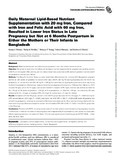Daily maternal lipid-based nutrient supplementation with 20 mg iron, compared with iron and folic acid with 60 mg iron, resulted in lower iron status in late pregnancy but not at 6 months postpartum in either the mothers or their infants in Bangladesh
Citation
Matias, S. L., Mridha, M. K., Young, R. T., Hussain, S., & Dewey, K. G. (2018). Daily maternal lipid-based nutrient supplementation with 20 mg iron, compared with iron and folic acid with 60 mg iron, resulted in lower iron status in late pregnancy but not at 6 months postpartum in either the mothers or their infants in Bangladesh. Journal of Nutrition, 148(10), 1615-1624. doi:10.1093/jn/nxy161Abstract
Background
Maternal anemia and iron deficiency are prevalent in low- and middle-income countries.
Objective
We aimed to determine the effects of lipid-based nutrient supplements for pregnant and lactating women (LNS-PL) on hemoglobin (Hb), anemia, and iron status (nonprimary outcomes) at 36 weeks of gestation (women) and 6 mo postpartum (women and infants).
Methods
The Rang-Din Nutrition Study, a cluster-randomized effectiveness trial, enrolled 4011 Bangladeshi pregnant women at ≤20 weeks of gestation to receive either daily LNS-PL (20 mg Fe) during pregnancy and the first 6 mo postpartum, or iron and folic acid (IFA, 60 mg Fe + 400 µg folic acid) daily during pregnancy and every other day during the first 3 mo postpartum. Biochemical measurements from a subsample of women (n = 1128) and their infants (n = 1117) included Hb (g/L), serum ferritin (µg/L), and soluble transferrin receptor (sTfR; mg/L). Anemia was defined as maternal Hb <110 g/L at 36 weeks of gestation, <120 g/L at 6 mo postpartum, or infant Hb <105 g/L; iron deficiency (ID) was defined as ferritin <12 µg/L or elevated sTfR (>8.3 mg/L for women and >11 mg/L for infants).
Results
Compared with the IFA group, women in the LNS-PL group had lower ferritin (–6.2 µg/L; P < 0.001) and higher sTfR concentrations (+0.5 mg/L; P < 0.001), and higher risk of ID (OR = 1.93; P < 0.05) at 36 weeks of gestation but not at 6 mo postpartum, whereas no consistent differences were observed for Hb or anemia. Among infants at 6 mo, there were no group differences except for a lower risk of elevated sTfR (OR = 0.61; P < 0.05) in the LNS-PL group than in the IFA group.
Conclusions
Provision of LNS-PL including a lower dose of iron than what is recommended during pregnancy resulted in differences in maternal iron status in late pregnancy that disappeared by 6 mo postpartum, and caused no undesirable effects regarding anemia or iron status of infants. This trial was registered at clinicaltrials.gov as NCT01715038.

